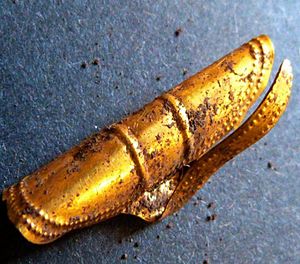Kirkhaugh cairns facts for kids
The Kirkhaugh cairns are two ancient burial sites from the Bronze Age (a time long ago when people used bronze tools). They are found in a place called Kirkhaugh in Northumberland, England. Scientists think there might even be a third burial site nearby!
These two confirmed graves were first dug up in 1935. Then, they were looked at again in 2014. The first grave, called Cairn 1, was very special. It held items that belonged to an important metalworker from the past. These items included two of the oldest gold decorations ever found in Britain! It also had one of the earliest "bell beakers," which are special ancient pots. The second grave, Cairn 2, was empty.
Digging Up the Past
The Kirkhaugh cairns were first dug up in 1935. A man named Herbert Maryon led this dig. He spent five days working there. Maryon was a sculpture teacher at Durham University. But he also loved archaeology, which is the study of old things. He often dug at ancient sites with his students.
Maryon and his helper, Joseph William Alderson, worked on September 18–21 and again on October 12.
When they removed the grass from the first mound, Maryon found many flat stones. These stones were piled on top of each other. Some were small, but others were very big, weighing up to 100 pounds! Under the stones, there was a mix of light soil and small rocks.
They did not find a body. But near the middle of the cairn, where a body might have been, they found greasy clay. Most of the special items were also found in this central area.
Maryon described the items he found:
- A crushed "food vessel" (an ancient pot).
- One gold "ear-ring."
- One flint arrowhead.
- One flint saw.
- Six worked pieces of flint.
- Two flint cores (pieces of flint used to make tools) and other unworked pieces.
- One whetstone (a tool for sharpening).
- One rough sandstone tool.
- One piece of glazed pottery.
- A handle from a vase or mug.
- A piece of rough pottery, a lump of iron, and some charcoal.
Most of these items were found in the middle of the cairn. The crushed pot was found a little further away.
Amazing Discoveries
The "food vessel" Maryon found was later identified as a "bell beaker." This type of pot is one of the very first ever found in Britain! What Maryon thought was an "ear-ring" was also re-identified. It was actually a hair braid, made of gold. This gold hair braid is one of the oldest metal objects ever found in the country.
In 2014, scientists dug at the cairns again. This time, community volunteers helped. Four boys were part of the team. Two of these boys were the great-grandsons of Joseph William Alderson, who helped Maryon in 1935! These boys made an amazing discovery: they found a second gold hair braid that matched the first one!


